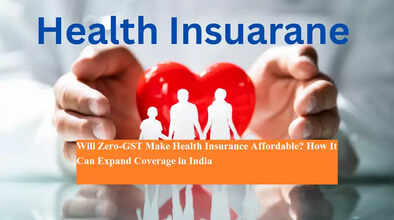Will Zero-GST Make Health Insurance Affordable? How It Can Expand Coverage in India

Health insurance continues to be a major challenge in India, even in 2025. According to the latest reports, nearly 30% of the population—over 40 crore people—still remain without any health insurance coverage. The reasons are clear: affordability issues, lack of awareness, and a tendency among younger people to postpone buying policies.
Government initiatives like Ayushman Bharat have expanded coverage for low-income groups, especially senior citizens. However, overall penetration remains limited, with total coverage hovering around 50% of the population. Experts believe that for true universal health protection, India must address both cost and accessibility barriers.
Rising Cost of Medical Care
Healthcare expenses in India have surged dramatically. In 2024–25 alone, medical treatment costs increased by nearly 14%. This rise has added significant financial pressure on families, particularly those without adequate insurance coverage. For many, one hospitalization can wipe out years of savings, underlining the need for stronger insurance adoption.
Why Zero-GST Could Be a Game Changer
Currently, health insurance premiums are taxed under GST, which adds to the burden for policyholders. If the government were to remove GST on health insurance premiums (Zero-GST policy), experts believe it could:
-
✅ Lower premium costs, making insurance more affordable for middle-class and low-income families.
-
✅ Encourage first-time buyers, especially younger individuals who often delay purchasing policies due to cost.
-
✅ Boost penetration in the retail sector, which is currently growing at a slower pace compared to corporate group insurance plans.
-
✅ Support preventive healthcare, as more affordable policies would increase access to wellness programs and digital health benefits offered by insurers.
Slow Growth in Retail, Stronger in Corporate
The private retail insurance sector is still expanding at a modest pace, while corporate-sponsored insurance plans remain relatively stronger in terms of coverage. This imbalance highlights the need for policy changes that make individual and family insurance policies more attractive and affordable.
Insurance companies, on their part, are increasingly focusing on digital claim settlements, wellness packages, and better customer experience to retain and attract policyholders. Yet, the overall cost remains a roadblock for millions.
Expert Advice: How Much Coverage is Enough?
Financial planners recommend that families opt for at least ₹10 lakh coverage for adequate protection. The amount of coverage should be aligned with the family’s age group, health requirements, and income. With rising treatment costs, under-insuring can lead to severe financial stress during medical emergencies.
Conclusion
Zero-GST on health insurance could potentially transform India’s insurance landscape by lowering premiums and encouraging broader participation. With medical costs rising and coverage still at just 50%, policy changes are crucial to ensure more citizens can access financial protection against health risks.
Until then, experts strongly advise individuals and families to not delay—choosing the right plan today can safeguard both health and financial stability tomorrow.

